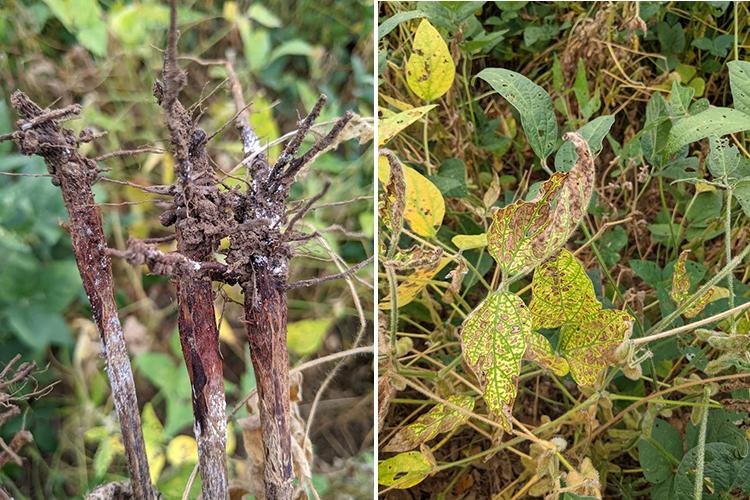Princeton, Kentucky, USA
September 23, 2021
 These two pictures show symptoms of red crown rot damage to soybean stems, roots and leaves. Photos by Carl Bradley, UK extension plant pathologist
These two pictures show symptoms of red crown rot damage to soybean stems, roots and leaves. Photos by Carl Bradley, UK extension plant pathologist
The University of Kentucky Plant Disease Diagnostic Lab in Princeton confirmed the first case of red crown rot in the state during the week of Sept. 13. At this point in the growing season, this disease will have the most impact on double-crop soybeans, said Carl Bradley, plant pathologist with the UK College of Agriculture, Food and Environment.
A local agronomist found the disease in a few soybean fields in Graves County, and he contacted UK to confirm the disease.
“Unfortunately, the disease is causing noticeable damage in the double-crop fields we scouted last week, and those fields will probably have yield losses,” Bradley said. “It will likely be too late for growers to observe red crown rot symptoms in full-season soybeans, as many of those fields are close to harvest.”
Red crown rot is caused by the fungus Calonectria ilicicola. The fungus infects soybean roots and causes root rot and dark red discoloration on the part of the stem closest to the soil. Red reproductive structures and white fungal growth may appear on the lower stem and roots. The fungus also produces a toxin that can accumulate in the leaves. It causes leaf tissue to turn yellow and die while the veins in the leaf remain green.
Soybean producers in Louisiana and Mississippi have dealt with this disease for years. There, the disease can cause as much as 25% to 30% yield loss. It was also found in Illinois in 2018.
“We will need to conduct research to determine the best management practices for this disease in Kentucky,” Bradley said. “We hope to be able to do some yield loss determinations in some of the fields we found red crown rot in last week.”
The fungus can survive in the soil for several years. Producers in southern states manage the disease by rotating away from soybeans, planting less-susceptible varieties and delaying planting in infected fields.
Kentucky producers who suspect they may have red crown rot should contact their county agriculture and natural resources agent with the UK Cooperative Extension Service. Agents can help producers submit samples for diagnosis at UK’s Plant Disease Diagnostic labs in Princeton or Lexington.
Additional information about the disease is available in Kentucky Pest News, https://kentuckypestnews.wordpress.com/.